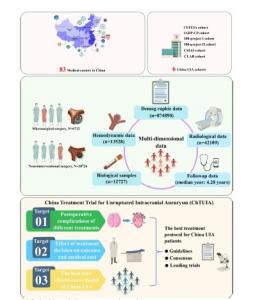Optimizing Surgical Strategies Through a Nationwide Trial: Insights from a Chinese Neurosurgical Journal Study
Researchers from China conduct a landmark national study to identify the best surgical strategies for treating unruptured brain aneurysms
BEIJING, BEIJING, CHINA, August 6, 2025 /EINPresswire.com/ -- Unruptured intracranial aneurysms (UIAs), a type of brain aneurysm, are balloon-like bulges found in the brain arteries caused by weakening and thinning of arterial walls. While surgical interventions are risky, UIAs always carry the risk of sudden rupture, which can lead to devastating hemorrhages with significant mortality rates. In China, approximately 7% of total adults suffer from UIAs. However, optimal surgical management strategies for UIAs remain poorly understood due to a lack of large-scale prospective studies in the Chinese population.To fill this gap, a group of researchers across various medical institutions came together to conduct the first of its kind, the China Treatment Trial for Unruptured Intracranial Aneurysm (ChTUIA). It is a national, prospective, observational, and multicenter registry study in China that is tracking 25,438 UIA patients across 83 medical centers. The trial is being led by Dr. Kaige Zheng and Dr. Zheng Wen from the Department of Neurosurgery, Beijing Tiantan Hospital, Capital Medical University, Beijing, China and China National Clinical Research Center for Neurological Diseases, Beijing, China. The protocols of the study were published online in Volume 11, Issue 8 of the Chinese Neurosurgical Journal on April 3, 2025.
“While there is advancement in the imaging techniques for analyzing brain aneurysms, there’s been no large-scale data guiding how best to treat these cases in our population,” explains principal investigator Dr. Zheng. “We believe the ChTUIA will provide vital information to guide patient-specific treatment strategies.”
To evaluate the treatment strategies, the trial will compare outcomes between 26.4% of patients who received microsurgical clipping and 73.6% who had endovascular procedures. Microsurgical clipping is a procedure that involves placing a tiny metal clip at the neck of the aneurysm to prevent blood from entering it. While more invasive, it is potentially more durable than endovascular procedures. Among the patients who received endovascular treatment, most underwent stent-assisted coiling, followed by flow diverter placement and coil embolization with or without balloon assistance.
Furthermore, to analyze the outcomes, the team collected over 874,000 clinical entries, 42,000 radiological scans, and 12,000 biological samples from the patients. The trial uses advanced data integration and centralized review to ensure accuracy and completeness. According to the protocols, the patients will be monitored for at least two years with follow-ups every three to six months. During these follow-ups, the neurological status, recurrence, and adverse events such as stroke or bleeding will be documented.
The primary outcome of the trial is neurological function, which will be measured at two years using the modified Rankin Scale (mRS). mRS measures a patient's level of disability or dependence in daily activities following stroke or intervention. Secondary outcomes will include treatment-related complications, cardiovascular events, cost assessments, and mortality.
China’s aging population and high burden of chronic health conditions make the treatment planning for UIAs more complex. Unlike western populations, Chinese patients may respond differently to therapies due to genetic, lifestyle, and clinical variations. ChTUIA is aimed to address this gap by analyzing treatments specific to the Chinese demographics instead of international data. Additionally, the study will also analyze the cost-effectiveness of different procedures, which is a critical aspect of healthcare planning in China.
“We are not just comparing surgical techniques in ChTUIA; we’re developing an entire decision-making framework that will blend clinical outcomes and patient profiles with economic considerations and long-term risks.” explains Dr. Wen.
With the support of China’s National Key Research and Development Program, ChTUIA is expected to influence not only national guidelines but also impact international best practices, especially for the East Asian populations. As the global burden of cerebrovascular disease continues to grow, this landmark study stands out to make a lasting contribution to brain health and evidence-based neurosurgery—paving the way for better treatment and surgical outcomes.
***
Reference
Titles of original papers: Treatment Strategies for Unruptured Intracranial Aneurysms in The Chinese Population: China Treatment Trial for Unruptured Intracranial Aneurysm (ChTUIA)
Journal: Chinese Neurosurgical Journal
DOI: https://doi.org/10.1186/s41016-025-00394-7
About the University
Capital Medical University (CCMU) was founded in 1960. It ranks among the top academic medical institutions in China, and is considered as one of the key municipal universities in Beijing. It consists of ten schools, 14 affiliated hospitals and one teaching institution. The university has over 9,000 enrolled students. CMU provides a wide range of educational programs for Doctorates, Masters, Bachelors and certificates.
Website: https://ccmu.cucas.cn/
About Dr. Kaige Zheng from Capital Medical University
Dr. Kaige Zheng is affiliated with the Department of Neurosurgery at Beijing Tiantan Hospital, Capital Medical University.
Funding information:
This study was supported by ‘National Key Research and Development Program of the 14th Five-Year Plan (Grant No. 2021YFC2501100)’.
Yi Lu
Chinese Neurosurgical Journal
luyi617@sina.cn
Legal Disclaimer:
EIN Presswire provides this news content "as is" without warranty of any kind. We do not accept any responsibility or liability for the accuracy, content, images, videos, licenses, completeness, legality, or reliability of the information contained in this article. If you have any complaints or copyright issues related to this article, kindly contact the author above.

